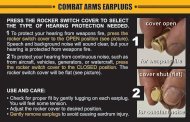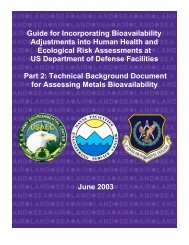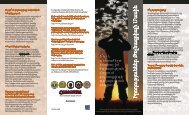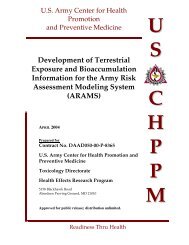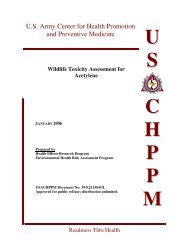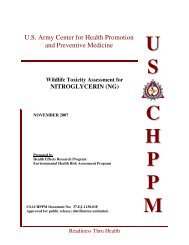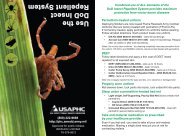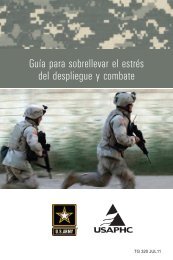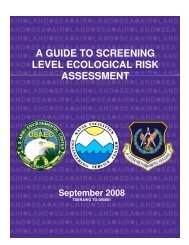Phenanthrene - U.S. Army Public Health Command
Phenanthrene - U.S. Army Public Health Command
Phenanthrene - U.S. Army Public Health Command
Create successful ePaper yourself
Turn your PDF publications into a flip-book with our unique Google optimized e-Paper software.
WILDLIFE TOXICITY ASSESSMENT FOR PHENANTHRENEeffects on blood chemistry in rats. Though not applicable to derivation of a TRV, these studies stillprovide toxicity information bearing on the potential effects to wildlife.2.3.4.2 Mammalian Toxicity-Other- SubacuteIn one of the few published experiments to explore the toxicological effects of phenanthrene, thecompound was administered to male Holtzman and Charles River rats (12 animals/group) for 7 days viaintraperitoneal injection (0.35 mg/rat/day) (Gershbein 1975). Rats were terminated three days later atwhich point the body weights and excised liver weights were recorded and compared to those of untreatedcontrols. The near identity in group-specific body weights and the close similarity between the liverweights of test versus control animals indicated that phenanthrene had little toxic impact on the subjects atthe administered dose. The use of this dose (approximately 1.38 mg/kg-day) as a No-Observed-Adverse-Effects-Level (NOAEL) is complicated, and of extremely low confidence, since no toxic effects ofphenanthrene have been defined in this or any other study. Furthermore the use of a single dose levelprecludes the delineation of the compound's toxicological threshold.2.3.5. Studies Relevant for Mammalian TRV DevelopmentIn the single study that was identified as potentially relevant to TRV development, the absence of anytoxicological consequences of phenanthrene administration in rats at the only dose tested did not allow adependable Low-Observed-Adverse-Effect-Level (LOAEL) or No-Observed-Adverse-Effect-Level(NOAEL) to be identified (Gershbein 1975). Physiological experiments by Rahman et al. (1986) suggestthat phenanthrene's inactivity is probably not related to failure to penetrate the intestinal mucosa where, atleast in male Sprague-Dawley rats, the compound appeared to be more or less quantitatively absorbed.The use of other protocols has pointed to the largely benign nature of phenanthrene in experimentalsystems. Thus, the compound appears to be negative in the Ames test, even in circumstances where itsreactive metabolite, phenanthrene 9,10 oxide, itself brings about gene reversion in Salmonellatyphimurium strains TA98, TA100, TA1537 and TA1538 (Bucker et al. 1979). However, when Bucker etal. (1979) included the epoxide hydratase inhibitor, 1,1,1-trichloropropene 2,3-oxide in the culturemedium, they observed the formation of histidine-independent colonies, which suggests thatphenanthrene is normally inactive in this system because its active metabolite normally cannotaccumulate. More recent studies have shown phenanthrene to be weakly positive in TA100, butineffective in TA98 (Bos et al. 1988).In the battery of experiments aimed at researching the ability of PAHs to induce or initiate skin tumorsin mice, phenanthrene has been found to be inactive under most experimental conditions and does notbehave like a complete carcinogen (Faust et al. 1993; ATSDR 1995).Page 9 of 14



